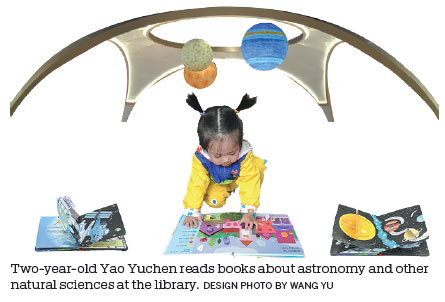Why bring your girl to a bookstore?
I've recently become hooked on taking my two-year-old daughter to visit children's bookstores, and with more and more of them popping up around Beijing, there are plenty to choose from when I'm drawing up my "must-see" list.
Whenever I cheerfully try to talk about my daughter's love for story time at kids bookstores, my single friends immediately interrupt me, saying things like: "She's just a toddler, please!" or "Why are you taking your little girl to go to bookstores, are you crazy?"
If I wasn't so lucky to become a new mum two years ago, I probably wouldn't have ever experienced the magic of children's bookstores or realized the differences between our two generations that these visits have highlighted.
When my generation were toddlers, having a picture book was an extravagance, so to us it might at first appear ridiculous to have specialized bookstores for kids. So, my friends naturally assumed that I was forcing my daughter to learn Mandarin by buying textbooks.
Actually, with so many fascinating children's bookstores opening up across the country in recent years, more and more lower-aged kids, even months-old toddlers, can now be seen playing in bookshops.
Can they read? Of course, not! So, what are these "over-worried" parents up to? For toddlers, there are no differences between reading and playing, books and toys. Parents simply bring them to bookshops because they want to foster a love of reading in their kids.
In our minds, libraries and bookstores are quiet places where you don't make noise and the shelves are so high that everyone hides their head in a book. They are boring, stifling - and perhaps even cruel - places to bring a little girl.
However, things are totally different today. These children's bookshops are luxurious settings that can easily transport their pint-sized customers into a world of color, fantasy and imagination.
Fairy-tale tree houses, cozy nooks and curvaceous wooden reading dens - the numerous design features in children's bookstores create an atmosphere that prevents children from wanting to leave and makes adults feel like they to want to be children again.
To ensure the children's safety, the interior design of children' bookstores always avoid sharp corners and straight lines.
When people of my generation were very young, parents were more focused on providing for us in an era characterized by a lack of food and clothing, and no one had time to take care of our reading needs. The most important things were the basics in life, and picture books were few and far between.
But for my daughter's generation, the reading choices are endless. Sturdy books made of board that can't be easily torn or chewed up, fabric books, waterproof books... Some books even add sounds and textures that help stimulate an infant's senses.
So what does my young daughter read when she goes to these bookstores? Eight Little Planets is a one favorite. Hello, World! Is another. Books like Solar System, Peep Inside Space, and Peppa Pig are also popular choices.
These books for very young children are mostly picture-based with the illustrations and text both presented in an easy-to-understand format. Many of them feature interactive elements like tabs and pop-ups and other fun things inside.
Take the book Peep Inside Space for example. It's so detailed that my daughter spends a lot of time poring over each page, opening every flap and pulling every tab.
Interactive books like this can be found in every children's bookstores. Are they cheap? Definitely not! Even the rental fees are not cheap. But they are nothing if not popular.
The market for kids books is expanding both in terms of sales and the diversity of its output. According to Beijing-based Open Book, a clearinghouse for publishing statistics, the children's segment saw double-digit expansion in the last four years - 19.7 percent, 28.8 percent, 21.2 percent, and 13.7 percent in 2015, 2016, 2017, and 2018, respectively. The sector is so strong now that it accounts for 25 percent of China's total retail book market.
Life has changed significantly for the children of the 2010s, compared to the kids of the 1980s. As with China's development, the market for children's books is still on a roll and expanding ever-faster - and there's no doubt that parents like me are contributing to this.
wangyu2012@chinadaily.com.cn

(China Daily 04/06/2019 page6)














